Impact of Building Energy Mitigation Measures on Future Climate
Abstract
1. Introduction
2. Methodology
2.1. GCM Ensemble
2.2. Statistical Bias Correction (SBC)
2.3. Dynamic Downscaling for Future Climate Change
3. Results
3.1. Impacts of Climate Change: GCM Ensemble of SBC (Static Bias Correction) Projections
3.2. Dynamic Downscaling Model Validation
3.3. Dynamic Downscaling Model Results for Climate Change Impacts on Extreme Heat Events
3.4. Dynamic Downscaling Model Results for Climate Change Impacts on Heat Index
3.5. Model Results for Climate Change Impacts on the Boundary Layer
3.6. Model Results for Climate Change Impacts on UHI
4. Discussion
5. Conclusions
Author Contributions
Funding
Institutional Review Board Statement
Informed Consent Statement
Data Availability Statement
Acknowledgments
Conflicts of Interest
Ethics Approval
Consent to Participate
Consent for Publication
References
- Intergovernmental Panel on Climate Change, IPCC. Climate Change, IPCC. Climate Change 2007. The Physical Science Basis. In Contribution of Working Group I to the Fourth Assessment Report of the Intergovernmental Panel on Climate Change; Cambridge University Press: Cambridge, UK, 2017. [Google Scholar]
- Gamble, D.W.; Curtis, S. Caribbean precipitation: Review, model and prospect. Prog. Phys. Geogr. 2008, 32, 265–276. [Google Scholar] [CrossRef]
- Angeles, M.E.; González, J.E.; Ramírez-Beltrán, N.D.; Tepley, C.A.; Comarazamy, D.E. Origins of the Caribean rainfall bimodal behavior. J. Geophys. Res. Atmos. 2010, 115. [Google Scholar] [CrossRef]
- Glenn, E.; Comarazamy, D.; González, J.E.; Smith, T. Detection of recent regional sea surface temperature warming in the Caribbean and surrounding region. Geophys. Res. 2015, 42, 6785–6792. [Google Scholar] [CrossRef]
- Hosannah, N.; González, J.; Rodriguez-Solis, R.; Parsiani, H.; Moshary, F.; Aponte, L.; Armstrong, R.; Harmsen, E.; Ramamurthy, P.; Angeles, M.; et al. The convection, aerosol, and synoptic-effects in the tropics (cast) experiment. Bull. Amer. Meteorol. Soc. 2017, 98, 1593–1600. [Google Scholar] [CrossRef]
- Angeles, E.M.; Gonzalez, J.E.; Ramirez, N. Impacts of climate change on building energy demands in the intra-Americas region. Theor. Appl. Clim. 2017, 133, 59–72. [Google Scholar] [CrossRef]
- Wang, N.; Phelan, P.E.; Gonzalez, J.; Harris, C.; Henze, G.P.; Hutchinson, R.; Langevin, J.; Lazarus, M.A.; Nelson, B.; Pyke, C.; et al. Ten Questions Concerning Future Building Beyond Zero Energy and Carbon Neutrality. Build. Environ. 2017, 119, 169–182. [Google Scholar] [CrossRef]
- González, J.E.; Georgescu, M.; Lemos, M.C.; Hosannah, N.; Niyogi, D. Climate change’s pulse is in Central America and the Caribbean. Eos 2017. [Google Scholar] [CrossRef]
- Karl, T.R.; Knight, R.W. The 1995 Chicago heat wave:Howl ikely is a recurrence? Bull. Amer. Meteor. Soc. 1997, 78, 1107–1119. [Google Scholar] [CrossRef]
- Delworth, T.L.; Mahlman, J.D.; Knutson, T.R. Changes in Heat Index associated with CO2-induced global warming. Clim. Chang. 1999, 43, 369–386. [Google Scholar] [CrossRef]
- Deo, R.C.; Mcalpine, C.A.; Syktus, J.; Mcgowan, H.A.; Phinn, S. On Australian Heat Waves: Time Series Analysis of Extreme Temperature Events in Australia, 1950–2005. In Proceedings of the MODSIM 2007 International Congress on Modelling and Simulation, Christchurch, New Zealand, 10–13 December 2007. [Google Scholar]
- Robinson, P.J. On the Definition of a Heat Wave. J. Appl. Meteorol. Climatol. 2001, 40, 762–775. [Google Scholar] [CrossRef]
- Fischer, E.M.; Schär, C. Consistent geographical patternsof changes in high-impact European heatwaves. Nat. Geosci. 2010, 3, 398–403. [Google Scholar] [CrossRef]
- Ramirez-Beltran, N.D.; Gonzalez, J.E.; JCastro, J.M.; Angeles, M.; Harmsen, E.W.; Salazar, C.M. Analysis of the heat index in the Mesoamerica and Caribbean region. J. Appl. Meteorol. Climatol. 2017, 56, 2905–2925. [Google Scholar] [CrossRef]
- Angeles-malaspina, M.; González-cruz, J.E.; Ramírez-Beltran, N. Projections of Heat Waves Events in the Intra-Americas Region Using Multimodel Ensemble. Adv. Meteorol. 2018, 2018, 18–21. [Google Scholar] [CrossRef]
- Méndez-Lázaro, P.; Martínez-Sánchez, O.; Méndez-Tejeda, R.; Rodríguez, E.; Morales, E.; Schmit Cortijo, N. Extreme Heat Events in San Juan Puerto Rico: Trends and Variability of Unusual Hot Weather and its Possible Effects on Ecology and Society. J. Climatol. Weather. Forecast. 2015, 3, 1000135. [Google Scholar] [CrossRef]
- Méndez-Lázaro, P.A.; Pérez-Cardona, C.M.; Rodríguez, E.; Martínez, O.; Taboas, M.; Bocanegra, A.; Méndez-Tejeda, R. Climate change, heat, and mortality in the tropical urban area of San Juan, Puerto Rico. Int. J. Biometeorol. 2016, 62, 699–707. [Google Scholar] [CrossRef]
- Li, D.; Bou-Zeid, E. Synergistic interactions between urban heat islands and heat waves: The impact in cities is larger than the sum of its parts. J. Appl. Meteorol. Climatol. 2013, 52, 2051–2064. [Google Scholar] [CrossRef]
- Ramamurthy, P.; González, J.; Ortiz, L.; Arend, M.; Moshary, F. Impact of heatwave on a megacity: An observational analysis of New York City during July 2016. Environ. Res. Lett. 2017, 12, 054011. [Google Scholar] [CrossRef]
- Li, D.; Sun, T.; Liu, M.; Wang, L.; Gao, Z. Changes in wind speed under heat waves enhance urban heat islands in the Beijing Metropolitan Area. J. Appl. Meteorol. Climatol. 2016, 55, 2369–2375. [Google Scholar] [CrossRef]
- Founda, D.; Santamouris, M. Synergies between urban heat island and heat waves in Athens (Greece), during an extremely hot summer (2012). Sci. Rep. 2017, 7, 10973. [Google Scholar] [CrossRef]
- Schatz, J.; Kucharik, C.J. Urban climate effects on extreme temperatures in Madison, Wisconsin, USA. Environ. Res. Lett. 2015, 10, 094024. [Google Scholar] [CrossRef]
- Scott, A.A.; Waugh, D.W.; Zaitchik, B.F. Reduced urban heat island intensity under warmer conditions. Environ. Res. Lett. 2018, 13, 064003. [Google Scholar] [CrossRef] [PubMed]
- He, B.-J. Towards the next generation of green building for urban heat island mitigation: Zero UHI impact building. Sustain. Cities Soc. 2019, 50, 101647. [Google Scholar] [CrossRef]
- United Nations Environment Programme UNEP. Climate Change in Latin America and the Caribbean: Current State and Opportunities. In Proceedings of the 14th Meeting of the Forum of Ministers of the Environment of Latin America and the Caribbean, Panama City, Panama, 20–25 November 2003; Volume 1, pp. 1–27. [Google Scholar]
- United Nations Environment Programme UNEP. Promotion of Newand Renewable Sources of Energy, Including the Implementation of the WorldSolar Programme 1996–2005; Report of the Secretary General-UNEP; 55th Session; Article 97f; UNEP: Nairobi, Kenya, 2000; pp. 1–7. [Google Scholar]
- Reyna, J.; Chester, M. Energy efficiency to reduce residential electricity and natural gas use under climate change. Nat. Commun. 2017, 8, 14916. [Google Scholar] [CrossRef] [PubMed]
- Salamanca, F.; Georgescu, M.; Mahalov, A.; Moustaoui, M.; Martilli, A. Citywide Impacts of Cool Roof and Rooftop Solar Photovoltaic Deployment on Near-Surface Air Temperature and Cooling Energy Demand. Boundary-Layer Meteorol. 2016, 161, 203–221. [Google Scholar] [CrossRef]
- Roman, K.K.; O’Brien, T.; Alvey, J.B.; Woo, O.J. Simulating the Effects of Cool Roof and PCM (Phase Change Materials) Based Roof to Mitigate UHI (Urban Heat Island) in Prominent US Cities. Energy 2016, 96, 103–117. [Google Scholar] [CrossRef]
- Rosenfeld, A.H.; Akbari, H.; Bretz, S.; Fishman, B.L.; Kurn, D.M.; Sailor, D.; Taha, H. Mitigation of urban heat islands: Materials, utility programs, updates. Energy Build. 1995, 22, 255–2653. [Google Scholar] [CrossRef]
- Akbari, H.; Pomerantz, M.; Taha, H. Cool surfaces and shade trees to reduce energy use and improve air quality in urban areas. Sol. Energy 2001, 70, 295–310. [Google Scholar] [CrossRef]
- Oleson, K.W.; Bonan, G.B.; Feddema, J. Effects of White Roofs on Urban Temperature in a Global Climate Model. Geophys. Res. Lett. 2010, 37, L03701. [Google Scholar] [CrossRef]
- Cotana, F.; Rossi, F.; Filipponi, M.; Coccia, V.; Pisello, A.L.; Bonamente, E.; Petrozzi, A.; Cavalaglio, G. Albedo Control as an Effective Strategy to Tackle Global Warming: A Case Study. Appl. Energy 2014, 130, 641–647. [Google Scholar] [CrossRef]
- Ortiz, L.E.; Gonzalez, J.G.; Gutierrez, E.; Arend, M. Forecasting Building Energy Demands with a Coupled Weather-Building Energy Model in a Dense Urban Environment. J. Sol. Energy Eng. 2016, 139, 011002. [Google Scholar] [CrossRef]
- Masson, V.; Bonhomme, M.; Salagnac, J.L.; Briottet, X.; Lemonsu, A. Solar panels reduce both global warming and urban heat island. Front. Environ. Sci. 2014, 2, 1–10. [Google Scholar] [CrossRef]
- Pokhrel, R.; Walker, A.; González, J.E. A new methodology to assess building integrated roof top PV installations at city scales: The tropical coastal city case. J. Eng. Sustain. Bldgs. Cities 2020, 1, 1–28. [Google Scholar] [CrossRef]
- Scherba, A. Modeling the Impact of Roof Reflectivity, Integrated Photovoltaic Panels and Green Roof Systems on the Summertime Heat Island. Master’s Thesis, Portland State University, Portland, OR, USA; p. 246. [CrossRef]
- Pokhrel, R.; Ramirez-Beltran, N.; González, J. On the assessment of alternatives for building cooling load reductions for a tropical coastal city. Energy Build. 2019, 182, 131–143. [Google Scholar] [CrossRef]
- Beccali, M.; Cellura, M.; Lo Brano, V.; Marvuglia, A. Forecasting daily urban electric load profiles using artificial neural networks. Energy Convers. Manag. 2004, 45, 2879–2900. [Google Scholar] [CrossRef]
- Howard, B.; Parshall, L.; Thompson, J.; Hammer, S.; Dickinson, J.; Modi, V. Spatial distribution of urban building energy consumption by end use. Energy Build. 2012, 45, 141–151. [Google Scholar] [CrossRef]
- Ahmed, K.; Ortiz, L.E.; González, J.E. On the Spatio-Temporal End-User Energy Demands of a Dense Urban Environment. J. Sol. Energy Eng. 2017, 139, 041005. [Google Scholar] [CrossRef]
- Olivo, Y.; Hamidi, A.; Ramamurthy, P. Spatiotemporal variability in building energy use in New York city. Energy 2017, 141, 1393–1401. [Google Scholar] [CrossRef]
- Vahmani, P.; Sun, F.; Hall, A.; Ban-Weiss, G. Investigating the climate impacts of urbanization and the potential for cool roofs to counter future climate change in Southern California. Environ. Res. Lett. 2016, 11, 124027. [Google Scholar] [CrossRef]
- Tewari, M.; Salamanca, F.; Martilli, A.; Treinish, L.; Mahalov, A. Impacts of projected urban expansion and global warming on cooling energy demand over a semiarid region. Atmos. Sci. Lett. 2017, 18, 419–426. [Google Scholar] [CrossRef]
- Ortiz, L.E.; Gonzalez, J.; Lin, W. Climate change impacts on peak building cooling energy demand in a coastal megacity. Environ. Res. Lett. 2018, 13, 94008. [Google Scholar] [CrossRef]
- URS. Fortieth Annual Report on the Electric Property of the Puerto RicoElectric Power Authority; URS: San Francisco, CA, USA, 2013; pp. 1–132. [Google Scholar]
- Reddy, T.A.; Kreider, J.F.; Curtiss, P.S.; Rabl, A. Heating and Cooling of Buildings: Principles and Practice of Energy Efficient Design; CRC Press: Boca Raton, FL, USA, 2016. [Google Scholar]
- Edwards, E.E.; Iyare, O.S.; Moseley, L.L. Energy consumption in typical Caribbeanoffice buildings: A potential short term solution to energy concerns. Renew. Energy 2012, 39, 154–161. [Google Scholar] [CrossRef]
- Taylor, K.E.; Stouffer, R.J.; Meehl, G.A. An overview of CMIP5 and the Experiment Design. Bull. Amer. Meteor. Soc. 2012, 93, 485–498. [Google Scholar] [CrossRef]
- van Vuuren, D.P.; Edmonds, J.; Kainuma, M.; Riahi, K.; Thomson, A.; Hibbard, K.; Hurtt, G.C.; Kram, T.; Krey, V.; Lamarque, J.-F.; et al. The representative concentration pathways: An overview. Clim. Chang. 2011, 109, 5–31. [Google Scholar] [CrossRef]
- Piani, C.; Weedon, G.P.; Best, M.; Gomes, S.M.; Viterbo, P.; Hagemann, S.; Haerter, J.O. Statistical bias correction of global simulated daily precipitation and temperature for the application of hydrological models. J. Hydrol. 2010, 395, 199–215. [Google Scholar] [CrossRef]
- Hawkins, E.; Osborne, T.M.; Ho, C.K.; Challinor, A.J. Calibration and bias correction of climate projections for crop modelling: An idealised case study over Europe. Agric. For. Meteorlogy 2013, 170, 19–31. [Google Scholar] [CrossRef]
- Bruyère, C.L.; Done, J.M.; Holland, G.J.; Fredrick, S. Bias corrections of global models for regional climate simulations of high-impact weather. Clim. Dyn. 2014, 43, 1847–1856. [Google Scholar] [CrossRef]
- Miller, N.L.; Hayhoe, K.; Jin, J.; Auffhammer, M. Climate, extreme heat, and electricity demand in California. J. Appl. Meteorol. Climatol. 2008, 47, 1834–1844. [Google Scholar] [CrossRef]
- El-Samra, R.; Bou-Zeid, E.; El-Fadel, M. To what extent does high-resolution dynamical downscaling improve the representation of climatic extremes over an orographically complex terrain? Theor. Appl. Climatol. 2017, 134, 265–282. [Google Scholar] [CrossRef]
- Wang, J.; Kotamarthi, V.R. High-resolution dynamically downscaled projections of precipitation in the mid and late 21st century over North America. Earth’s Future 2015, 3, 268–288. [Google Scholar] [CrossRef]
- Gao, Y.; Fu, J.S.; Drake, J.B.; Liu, Y.; Lamarque, J.-F. Projected changes of extreme weather events in the eastern United States based on a high-resolution climate modeling system. Environ. Res. Lett. 2012, 7, 044025. [Google Scholar] [CrossRef]
- Ortiz, L.E.; González, J.E.; Horton, R.; Wei, W.L.; Ramamurthy, P.; Arend, M.; Bornstein, R.D. High-resolution projections of extreme heat in New York City. Int. J. Climatol. 2019, 39, 4721–4735. [Google Scholar] [CrossRef]
- Lanzante, J.R.; Dixon, K.W.; Nath, M.J.; Whitlock, C.E.; Adams Smith, D. Some pitfalls in statistical downscaling of future climate. Bull. Am. Meteorol. Soc. 2018, 99, 791–803. [Google Scholar] [CrossRef]
- Zeppetello, L.R.V.; Raftery, A.E.; Battisti, D.S. Probabilistic projections of increased heat stress driven by climate change. Commun. Earth Environ. 2022, 3, 183. [Google Scholar] [CrossRef]
- Martins, J.; Rocha, A.; Viceto, C.; Cardoso, P.S.; Santos, J.A. Future Projections for Wind, Wind Shear and Helicity in the Iberian Peninsula. Atmosphere 2020, 11, 1001. [Google Scholar] [CrossRef]
- Adachi, S.A.; Kimura, F.; Kusaka, H.; Inoue, T.; Ueda, H. Comparison of the impact of global climate. Natl. Ocean. Atmos. Adm. 2012, 23, 473–493. [Google Scholar] [CrossRef]
- Lemonsu, A.; Viguié, V.; Daniel, M.; Masson, V. Vulnerability to heat waves: Impact of urban expansion scenarios on urban heat island and heat stress in Paris (France). Urban Clim. 2015, 14, 586–605. [Google Scholar] [CrossRef]
- Georgescu, M.; Moustaoui, M.; Mahalov, A.; Dudhia, J. Summer-time climate impacts of projected megapolitan expansion in Arizona. Nat. Clim. Chang. 2012, 3, 37–41. [Google Scholar] [CrossRef]
- Argüeso, D.; Evans, J.P.; Fita, L.; Bormann, K.J. Temperature response to future urbanization and climate change. Clim. Dyn. 2014, 42, 2183–2199. [Google Scholar] [CrossRef]

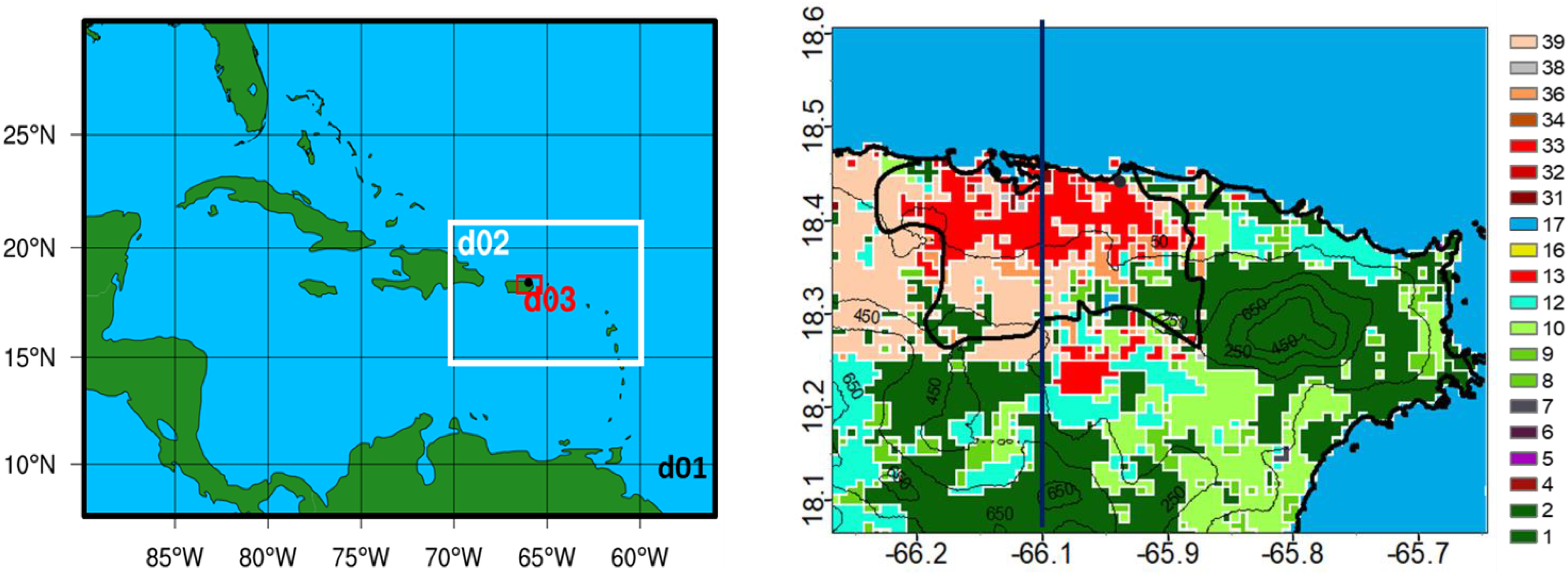
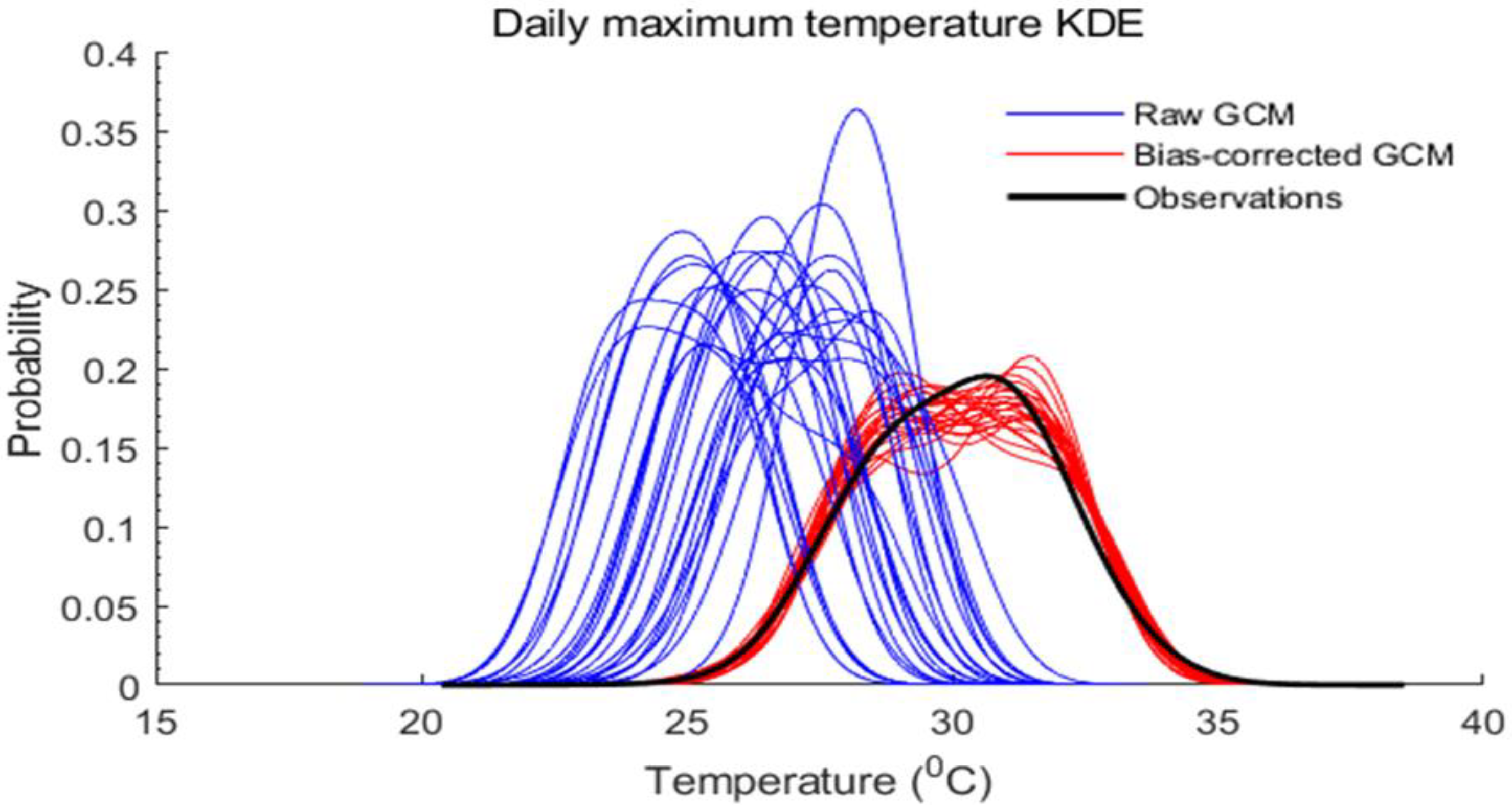
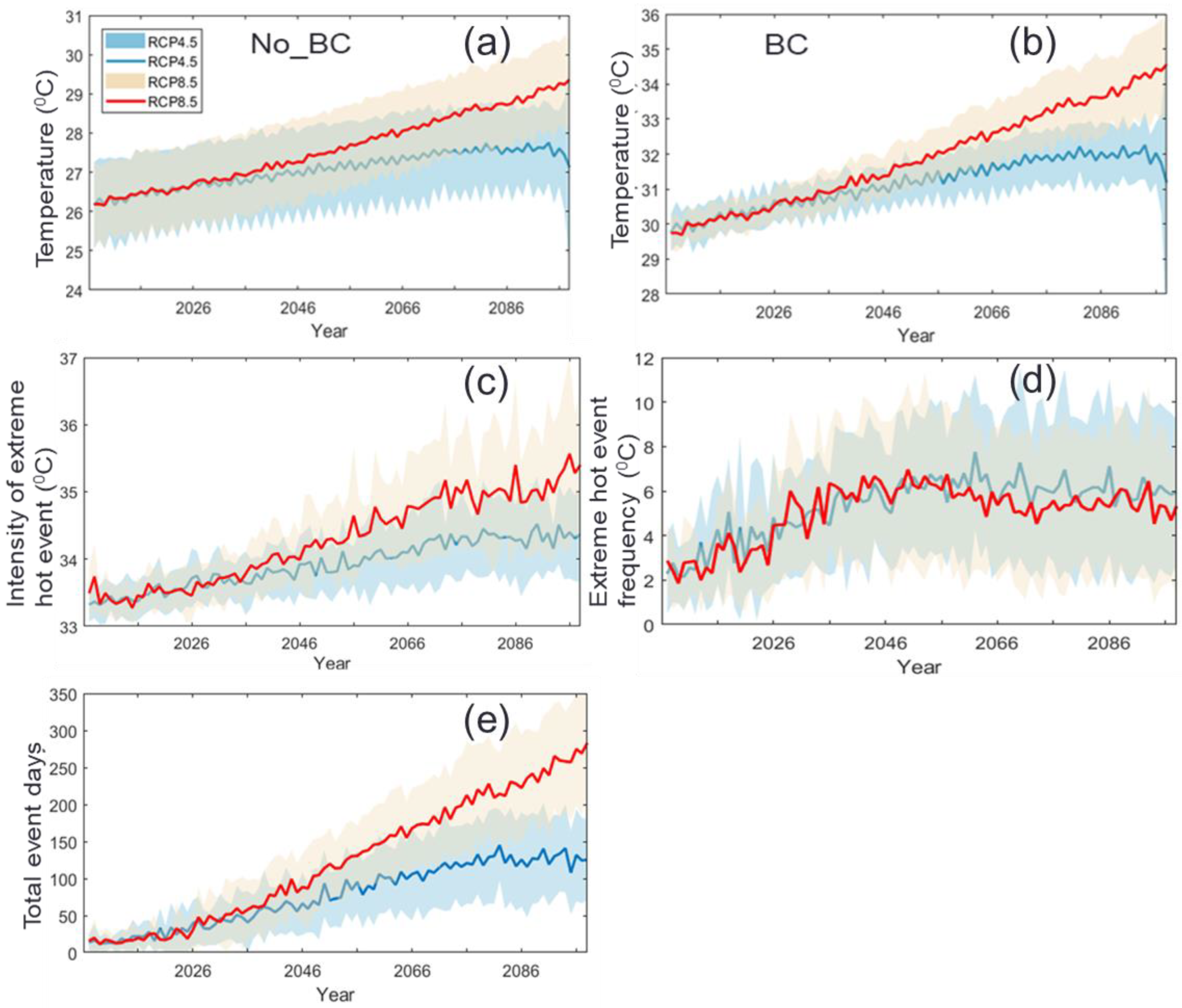

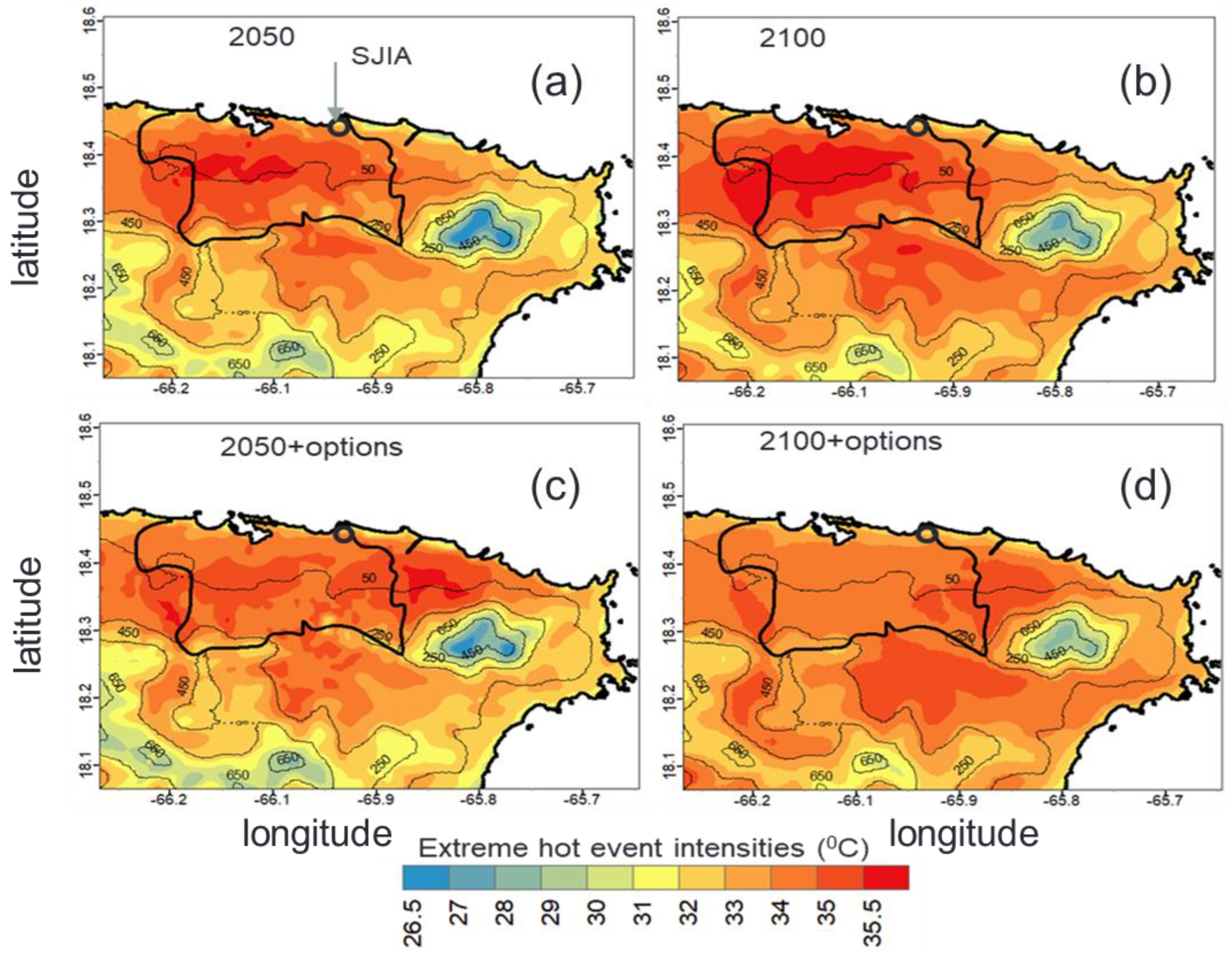
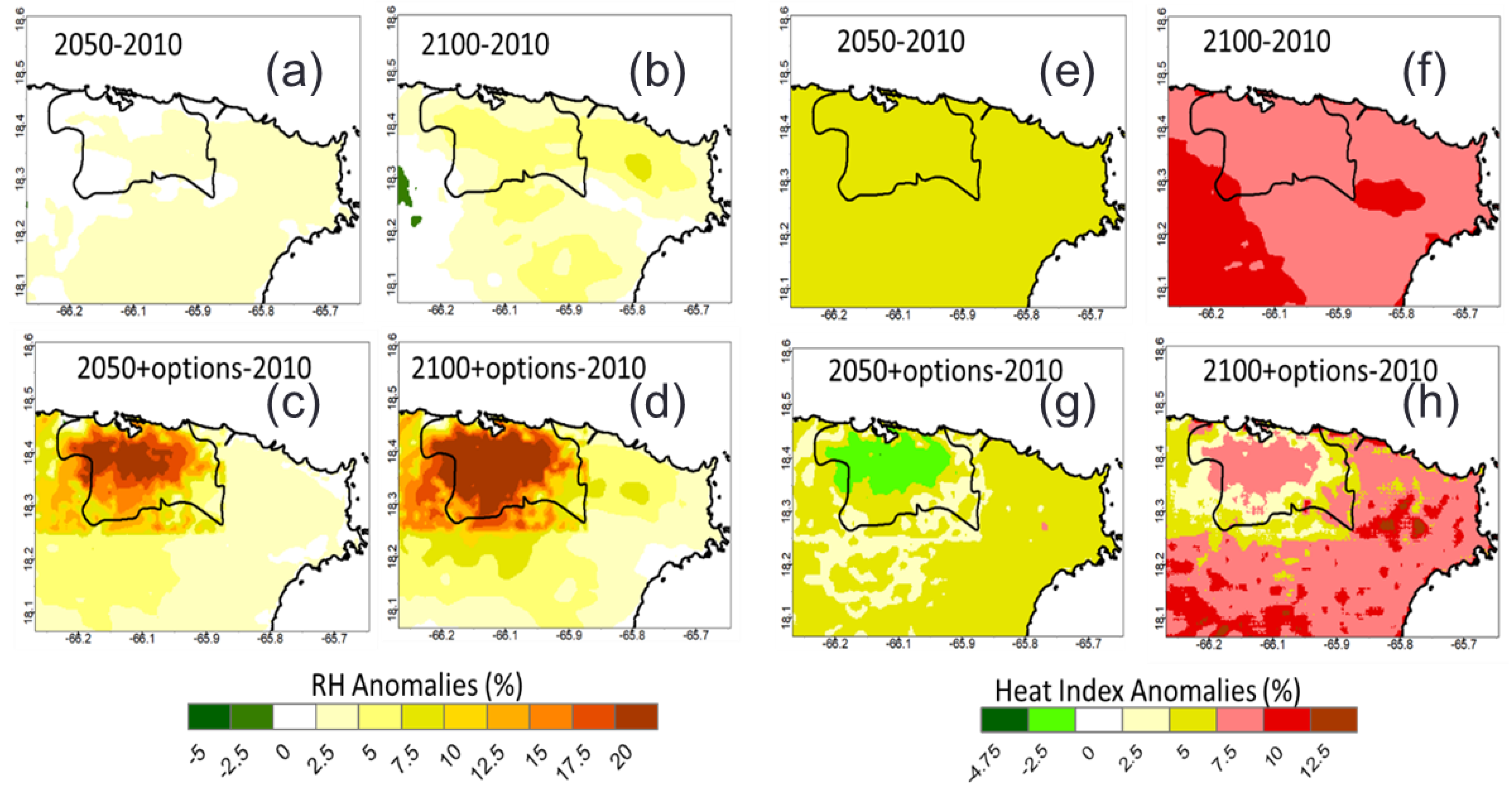

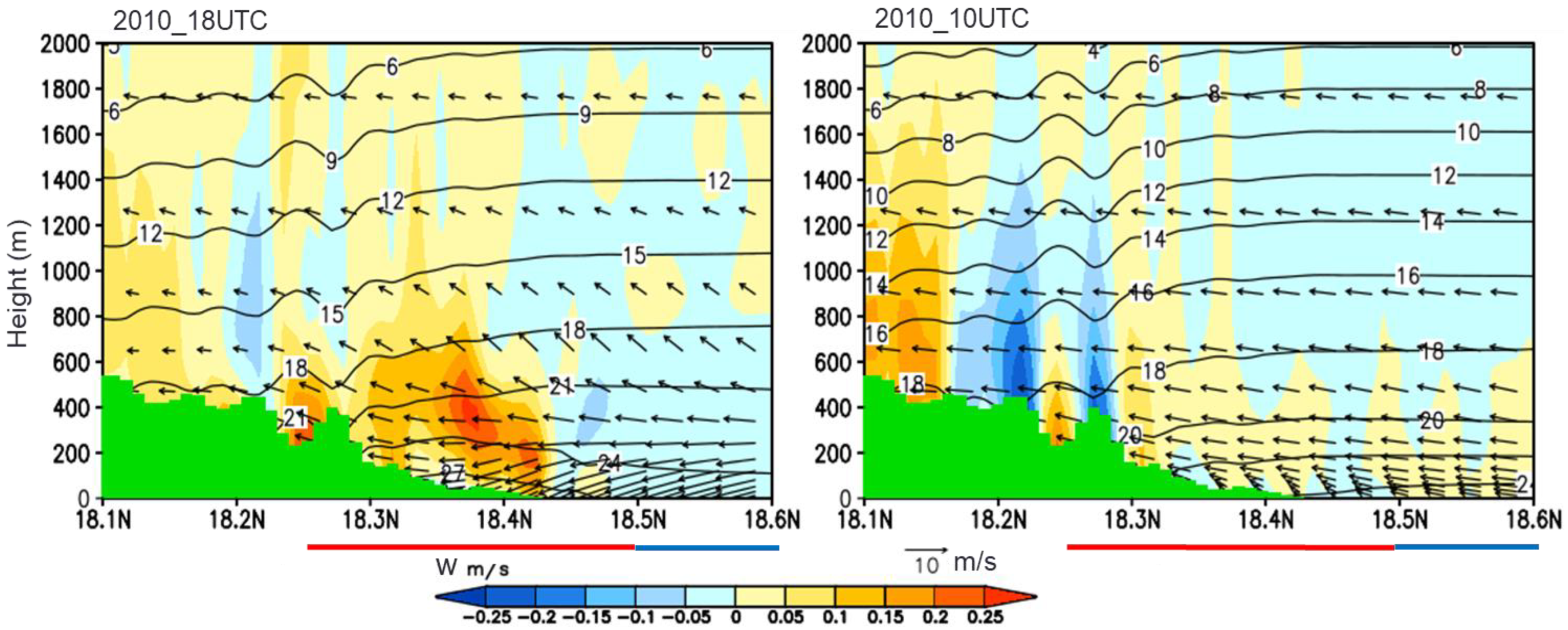

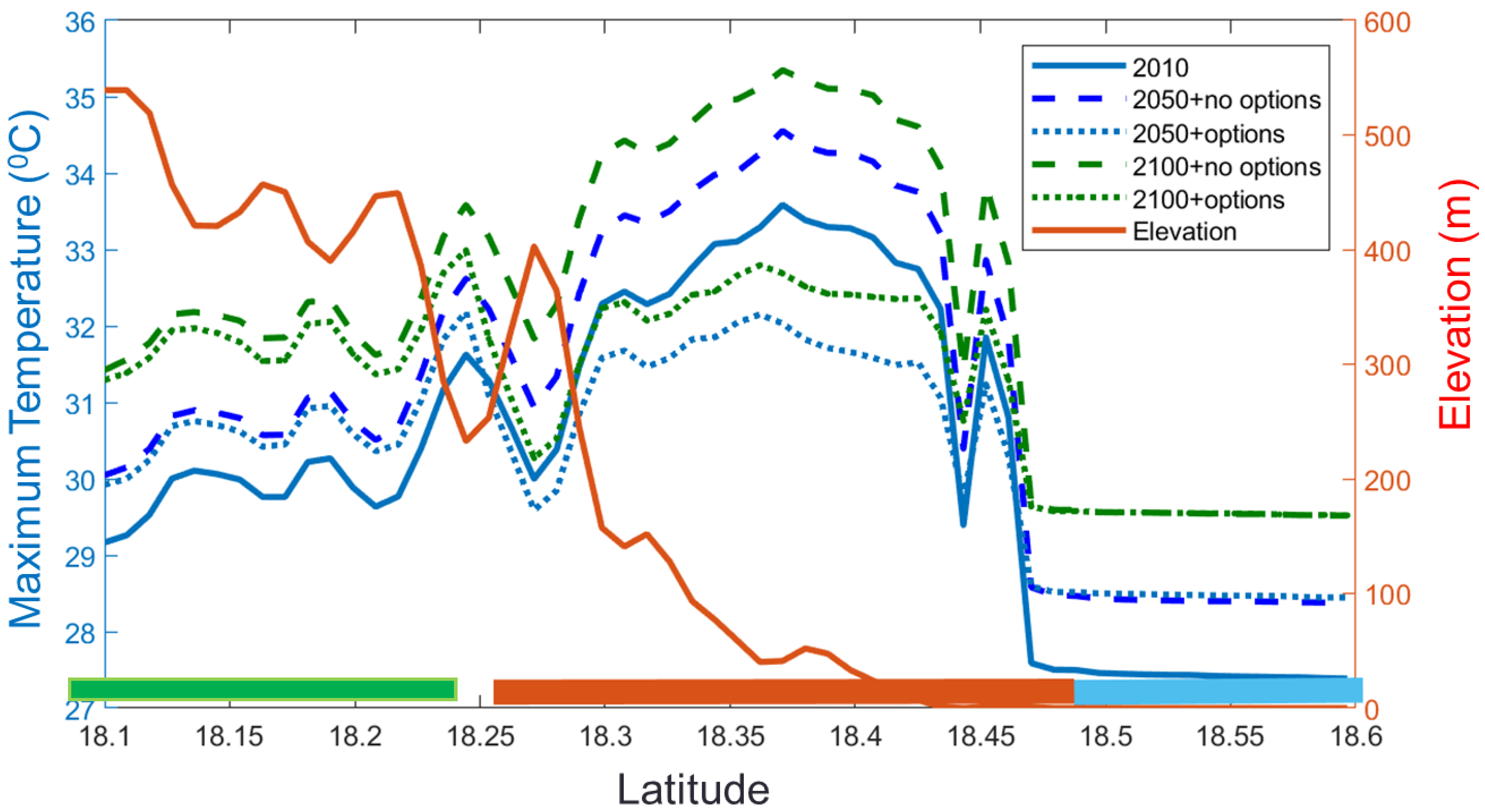
| Center | Model | Resolution (lat.° × lon.°) | Selected Coordinates (lat.° × lon.°) |
|---|---|---|---|
| Commonwealth Scientific and Industrial Research Organization: Bureau of Meteorology (Australia) | ACCESS1.0 ACCESS1.3 | 1.25 × 1.875 1.25 × 1.875 | 18.75 × −63.75 18.5 × −66 |
| Canadian Centre for Climate Modeling and Analysis (Canada) | CanESM2 | 2.7906 × 2.8125 | 18.139 × −67.5 |
| National Center for Atmospheric Research (United States) | CCSM4 | 0.9424 × 1.25 | 18.376 × −66.25 |
| Centro Euro-Mediterraneo per i Cambiamenti Climatici (Italy) | CMCC-CMS | 3.7111 × 3.75 | 17.72 × −65.625 |
| Centre National de Recherches Météorologiques/Centre Européen de Recherche et de Formation Avencée en Calcul Scientifique (France) | CNRM-CM5 | 1.4008 × 1.40625 | 18.911 × −66.094 |
| Commonwealth Scientific and Industrial Research Organization/Queensland Climate Change Centre of Excellence (Australia) | CSIRO-Mk3.6.0 | 1.8653 × 1.875 | 17.72 × −66.25 |
| NOAA Geophysical Fluid Dynamics Laboratory (United States) | GFDL-ESM2G GFDL-ESM2M | 2.0225 × 2 2.0225 × 2 | 19.214 × −66.25 19.214 × −66.25 |
| NASA Goddard Institute for Space Studies (United States) | GISS-CM3 GISS-E2-H GISS-E2-R | 2 × 2.5 2 × 2.5 2 × 2.5 | 19 × 66.25 19 × 66.25 19 × 66.25 |
| Met Office Hadley Centre (UK) | HadGEM2-AO HadGEM2-CC HadGEM2-ES | 1.25 × 1.875 1.25 × 1.875 1.25 × 1.875 | 18.75 × −66.625 18.75 × 66.625 18.75 × 66.625 |
| Institut Pierre Simon Laplace (France) | IPSL-CM5A-LR IPSL-CM5A-MR IPSL-CM5B-LR | 1.8947 × 3.75 1.2676 × 2.5 1.8946 × 3.75 | 18 × −67.5 17.7464 × −65 18 × −67.5 |
| Japan Agency for Marine-Earth Science and Technology, Atmosphere and Ocean Research Institute/National Institute for Environmental Studies/Japan Agency for Marine-Earth Science and Technology (Japan) | MIROC-ESM MIROC-ESM- CHEM MIROC5 | 2.7906 × 2.8125 2.7906 × 2.8125 1.4008 × 1.40625 | 18.13897 × −67.5 18.13897 × −67.5 18.91036 × −66.0938 |
| Max Planck Institute for Technology (Germany) | MPI-ESM-LR MPI-ESM-MR | 1.8653 × 1.875 1.8653 × 1.875 | 17.71996 × −65.625 17.71996 × −65.625 |
| Meteorological Research Institute (Japan) | MRI-CGCM3 | 1.12148 × 1.125 | 18.50458 × −66.375 |
| Institute for Numerical Mathematics (Russia) | MRI-CGCM3 | 1.5 × 2 | 18.75 × −66 |
Disclaimer/Publisher’s Note: The statements, opinions and data contained in all publications are solely those of the individual author(s) and contributor(s) and not of MDPI and/or the editor(s). MDPI and/or the editor(s) disclaim responsibility for any injury to people or property resulting from any ideas, methods, instructions or products referred to in the content. |
© 2023 by the authors. Licensee MDPI, Basel, Switzerland. This article is an open access article distributed under the terms and conditions of the Creative Commons Attribution (CC BY) license (https://creativecommons.org/licenses/by/4.0/).
Share and Cite
Pokhrel, R.; Gonzalez, J.E.; Ramamurthy, P.; Comarazamy, D. Impact of Building Energy Mitigation Measures on Future Climate. Atmosphere 2023, 14, 463. https://doi.org/10.3390/atmos14030463
Pokhrel R, Gonzalez JE, Ramamurthy P, Comarazamy D. Impact of Building Energy Mitigation Measures on Future Climate. Atmosphere. 2023; 14(3):463. https://doi.org/10.3390/atmos14030463
Chicago/Turabian StylePokhrel, Rabindra, Jorge E. Gonzalez, Prathap Ramamurthy, and Daniel Comarazamy. 2023. "Impact of Building Energy Mitigation Measures on Future Climate" Atmosphere 14, no. 3: 463. https://doi.org/10.3390/atmos14030463
APA StylePokhrel, R., Gonzalez, J. E., Ramamurthy, P., & Comarazamy, D. (2023). Impact of Building Energy Mitigation Measures on Future Climate. Atmosphere, 14(3), 463. https://doi.org/10.3390/atmos14030463






